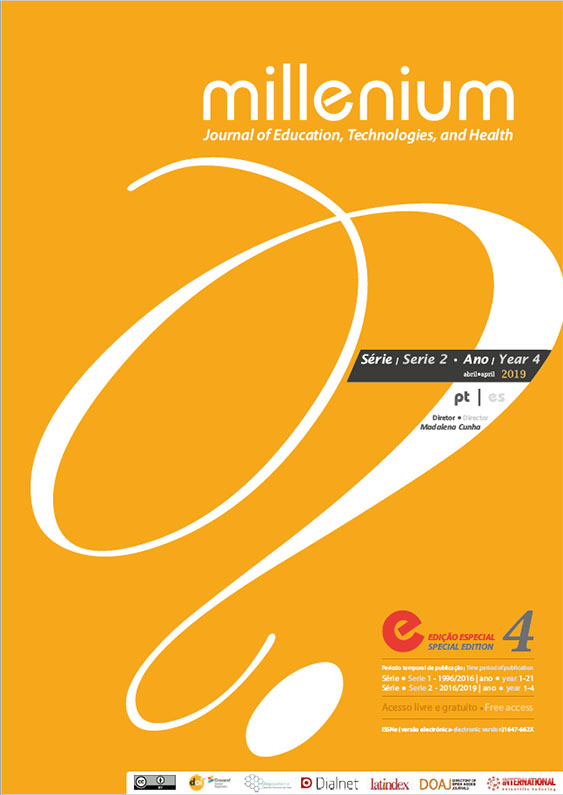Colaboração educativa para fomentar aprendizagens autênticas e preparar para a empregabilidade
DOI:
https://doi.org/10.29352/mill024e.15120Palavras-chave:
colaboração, competências, interpretação, língua inglesa, patrimónioResumo
Introdução: A necessidade de preparar os alunos do ensino superior para o mercado de trabalho passa por proporcionar o contacto com atividades em contexto real. Importa, todavia, considerar a mobilidade entre empresas e países, o que torna imprevisível o percurso da carreira profissional de cada um. Assim, o processo de ensino-aprendizagem deverá ser multidirecional, havendo preocupação de fornecer instrumentos e fontes de informação que possam ser usados na descoberta de conhecimento.
Objetivos: Dinamizar a colaboração interinstitucional; Fomentar a autenticidade situacional e comunicacional através de atividades reais de interpretação de património local através de visitas guiadas; Melhorar a maior qualidade dos outputs produzidos pelos estudantes; identificar as perceções dos alunos após a elaboração da atividade.
Métodos: Trata-se de um projeto de colaboração realizado no âmbito de unidades curriculares de inglês com estudantes de dois cursos superiores da área do Turismo, de cidades diferentes. O projeto contemplou uma fase de preparação, desenho de um roteiro com os principais pontos de interesse turístico da sua cidade. Após a elaboração de guiões interpretativos e no final da experiência de efetuar a visita guiada os alunos responderam a um questionário anónimo onde manifestaram as suas perceções.
Resultados: Da análise SWOT elaborada verificou-se que, entre outros aspetos, um dos pontos fortes desta tipologia de exercícios é a preparação para atividades futuras com públicos reais; os pontos fracos prendem-se com a perceção de insegurança perante os grupos reais; as ameaças indicadas centram-se, entre outros aspetos no grupo de visitantes; as oportunidades identificadas referem sobretudo a experiência positiva para enfrentarem o mercado de trabalho.
Conclusões: Os desenvolvimentos de atividades colaborativas interinstitucionais revelaram-se de interesse para os alunos sobretudo na perspetiva de preparação para situações semelhantes no mercado de trabalho.
Downloads
Referências
Adelman, C. (1993). Kurt Lewin and the origins of action research. Educational Action Research, 1(1), 7-24.
Coutinho, C., Sousa, A., Dias, A., Bessa, F., Ferreira, M. & Vieira, S. (2009). Investigação-acção: metodologia preferencial nas práticas educativas. Psicologia, Educação e Cultura, XIII(2), 455-479.
Mills, G. (2010). Action Research. A guide for the teacher researcher. London: Pearson.
Siemens, G. & Tittenberger, P. (2009). Handbook of Emerging Technologies for Learning. Disponível em http://techcommittee.wikis.msad52.org/file/view/HETL.pdf
Tudor, I. (2005). Higher Education language policy in Europe: A snapshot of action and trends [Discussion brief posted on the website of Task Group 1, Institution wide language policies, of the ENLU website].
Disponível em http://web.fu-berlin.de/enlu/
Wills, S., Leigh, E. & Ip, A. (2011). The power of role-based e-learning. New York: Routledge.
Wills, S., Rosser, E., Devonshire, E., Leigh, E., Russel, C., & Shepherd, J. (2009). Encouraging Role Based Online Learning Environments by Building, Linking, Understanding, Extending: the BLUE Report. Australian Teaching and Learning Council. Disponível em http://ro.uow.edu.au/cgi/viewcontent.cgi?article=1114&context=asdpapers
Downloads
Publicado
Como Citar
Edição
Secção
Licença
Direitos de Autor (c) 2019 Millenium - Journal of Education, Technologies, and Health

Este trabalho encontra-se publicado com a Licença Internacional Creative Commons Atribuição 4.0.
Os autores que submetem propostas para esta revista concordam com os seguintes termos:
a) Os artigos são publicados segundo a licença Licença Creative Commons (CC BY 4.0), conformando regime open-access, sem qualquer custo para o autor ou para o leitor;
b) Os autores conservam os direitos de autor e concedem à revista o direito de primeira publicação, permitindo-se a partilha livre do trabalho, desde que seja corretamente atribuída a autoria e publicação inicial nesta revista.
c) Os autores têm autorização para assumir contratos adicionais separadamente, para distribuição não-exclusiva da versão do trabalho publicada nesta revista (ex.: publicar em repositório institucional ou como capítulo de livro), com reconhecimento de autoria e publicação inicial nesta revista.
d) Os autores têm permissão e são estimulados a publicar e distribuir o seu trabalho online (ex.: em repositórios institucionais ou na sua página pessoal) já que isso pode gerar alterações produtivas, bem como aumentar o impacto e a citação do trabalho publica
Documentos necessários à submissão
Template do artigo (formato editável)





